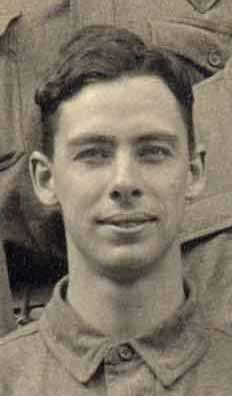(Ridley Park, Pennsylvania, April 20, 1890 – east of Cambrai, Sept. 29, 1918).1
England ✯ France and No. 22 ✯ September 29, 1918 ✯ Afterwards
Earl Adams was descended on his father’s side from a family that had resided in New Jersey and Delaware for several generations. His father, Samuel Ferdinand Adams, was the son of an iron worker and was himself a mechanical engineer. He married Isabel Brown, whose ancestors had recently come from the British Isles, in Philadelphia in 1886; their first child, a son who died in infancy, was born in Chicago. Earl Adams was born in Ridley Park, south of Philadelphia; a sister was born two years later in Camden, New Jersey, and another sister in 1896 in New York.2
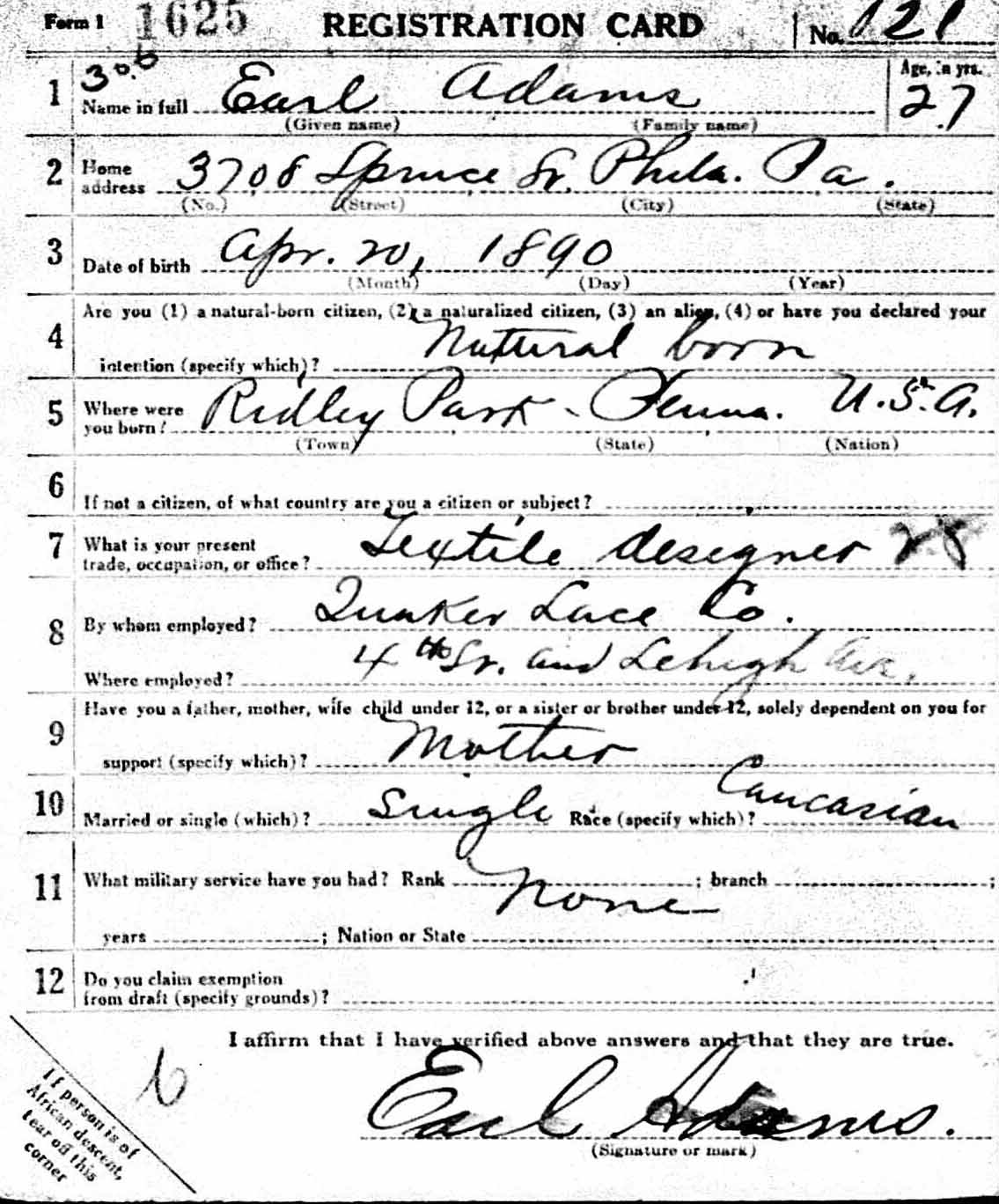
In 1910, according to census record information, Earl Adams was a lace designer with his own company.3 When he registered for the draft on June 5, 1917, he indicated that he was a textile designer at the Quaker Lace Company in Philadelphia and was supporting his widowed mother; I have found no information on his father’s death.
Adams applied to and was accepted by the Aviation Section of the Signal Corps. He attended ground schoolat Ohio State University, graduating Sept. 1, 1917.4 While in Columbus, he evidently became friendly with the family of Henry Curwen Lord, professor of astronomy and director of the Emerson McMillin Observatory at O.S.U.5
Along with most of his O.S.U. classmates, Adams chose or was chosen to train in Italy and sailed as one of the 150 cadets of the “Italian” or “second Oxford detachment” on the Carmania. They departed New York for Halifax on September 18, 1917, and sailed from Halifax on September 21, 1917, as part of a convoy that would cross the Atlantic together for safety. Violinist Albert Spalding, also on board, describes how, on being moved from steerage to first class, he was assigned to a state room with three cadets: “One of the three, a quiet lad by the name of Adams, told me of his love of music. He was shy about it. We were friends at once.”6 Spalding and Adams gave a violin concert together in the library the day after the ship left Halifax.7
England
After an uneventful crossing, the Carmania docked at Liverpool on October 2, 1917. There the cadets were ordered to proceed not to Italy as they expected, but to Oxford, where they were to attend ground school (again) under the auspices of the Royal Flying Corps’s No. 2 School of Military Aeronautics, much to their initial disgruntlement. Various explanations have been offered for the change of plans.8 Whatever the reason, the men of the detachment made their peace with the change and in retrospect recognized the benefit of R.F.C. training. Their British instructors, unlike the ones in the U.S., had had war flying experience, and this added considerable interest to the course work. Since the men had already covered much of the material, they did not have to study especially hard, and they enjoyed Oxford hospitality and explored the town and surrounding countryside. Another American detachment having already started ground school at Oxford in September, the one that arrived in October became the “second Oxford detachment.”
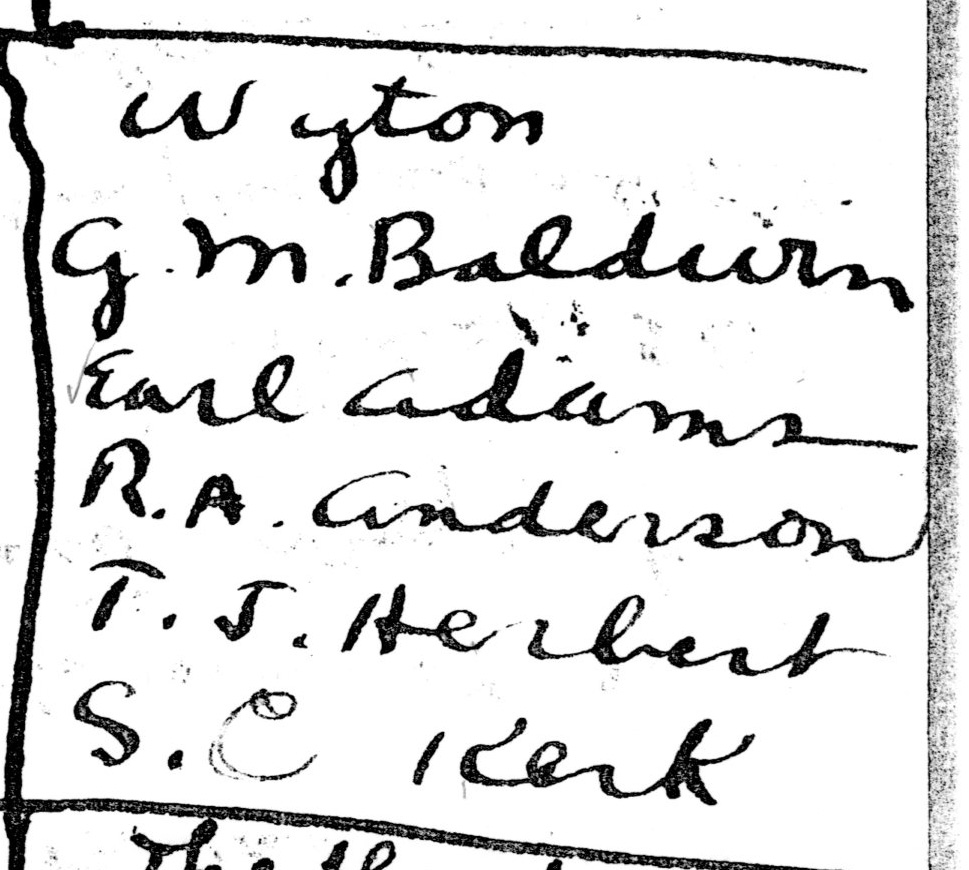
On November 3, 1917, Adams and most of the men in second Oxford detachment left Oxford for machine gun school at Harrowby Camp, near Grantham in Lincolnshire. About two weeks later, it was determined that fifty of the cadets could go to training squadrons.9 Adams was among the fortunate fifty, and on November 19, 1917, he went to No. 31 Training Squadron, which was then at Wyton, about fifteen miles northwest of Cambridge. Robert Alexander Anderson, Guy Maynard Baldwin, Thomas John Herbert, and Stanley Cooper Kerk were posted to Wyton at the same time—Herbert and Kerk had been at ground school with Adams.10
On December 28, 1917, Adams was transferred to No. 65 Training Squadron, which was stationed at Dover and trained pilots using Avros and Camels.11 Weather and flying opportunities must have been favorable, because by early February Adams had apparently completed all the requirements for graduation from this stage of training; his R.A.F. service record shows him appointed a Flying Officer on February 5, 1918. The recommendation for his commission as a first lieutenant was forwarded by Pershing to Washington on February 16, 1918; the confirming cablegram is dated March 1, 1918.12
There is little information on Adams’s subsequent training, other than that he was at Ayr in the latter part of March when he was placed on active duty.13 His R.A.F. service record indicates that he passed his medical boards in April 1918; it was recommended he be granted three weeks leave.
In early May of 1918 Adams was in London. Joseph Kirkbride Milnor, who had a desk job at American Aviation HQ there, noted in his diary on May 4, 1918, that “We had a sort of Columbus reunion at luncheon at the Knightsbridge. Dud Mudge, . . . Earl Adams, Red Wheeler, . . . and myself.” Adams’s name appears on a list of Sopwith Camels being flown from Lympne to Orly in early July 1918, thus documenting his work as a ferry pilot, which another source indicates lasted from spring until September.14

France and No. 22 Squadron R.A.F.
On September 11, 1918, according to his R.A.F. service record, Adams went to 1 Aeroplane Supply Depot (“1 A.S.D.”), located at Marquise, France, and from there, two days later, to No. 22 Squadron R.A.F.15 No. 22 was stationed at Maisoncelle, about ten miles northwest of St. Pol, and was flying Bristol F.2B’s, two-seaters designed for both fighting and reconnaissance.16 No. 22 was one of the squadrons of the 10th Army Wing, assigned to I Brigade, supporting the First Army, whose front was now located a few miles east of Arras. The duties of No. 22 Squadron included serving as escort during bombing raids and aerodrome strafing, as well as flying high level offensive patrols. Adams and Otis Harold Williamson were apparently the first—and perhaps the only—Americans to join the squadron.17
Adams’s arrival coincided with a period of relative calm due partly to bad weather but also the result of deliberate policy as preparations were being made for the final assault on the Hindenburg line towards the end of September.18 A squadron historian, William Frederick James Harvey, notes that during this period there were orders directing that “ ‘provided [the enemy] keeps well back at a distance behind his lines, the policy of seeking out and destroying his machines will be less actively pursued’.” Harvey continues: “On the 17th, 24th and 26th the squadron did its last escorts to low level aerodrome strafes, when Nos. 64 and 209 Squadrons attacked Emerchicourt; and ‘B’ Flight with no. 203 raided Lieu St. Armand.”19
Possibly referring to participation in the escort patrol for the raid on the aerodrome at Emerchicourt on September 17, 1918, Adams recounted in a letter to his mother from about September 22, 1918, how “I ran out of petrol while 8000 feet in the air, but glided and landed safely in a field behind our lines. The commander of our squadron came down to see what was wrong. Soon everything was O.K. and we ascended and rejoined our squadron. Later, the commander’s machine took a nose dive and landed, wrecking his machine.” The remainder of this incident is summarized: “The officer [Adams] wrote that he also descended to aid his commander. The latter requisitioned Adams’ machine, leaving him in a field from 9 A. M. to 6 P. M., when a scouting party returned, picked him up and carried him to camp.”20
Harvey describes how “at first light on the 27th, the First and Third Armies went into action,” advancing towards Cambrai.21 According to Jones, “First Army [aerial] offensive formations, to be provided by No. 19 and 22 Squadrons, were to patrol between 4,000 and 8,000 feet to protect the low-flying aircraft and day bombers, and were also to attack German aeroplanes and balloons in the area of operations.”22 Given the all out nature of the efforts beginning September 27, 1918, it is almost certain that Adams participated in patrols from the start of the offensive, and there is some documentation of his participation on the 28th. That day he wrote to Mrs. Henry Curwen Lord at O.S.U., remarking that “he was about to start on a flight.”23
September 29, 1918
The next day, September 29, 1918, Adams and his gunner/observer, George Herbert Bissell, flying Bristol F.2B E2266, set out around 10 a.m. on an offensive patrol. In January 1919 Chester William McKinley Thompson wrote to the squadron commander and recalled that:
Adams and I flew with ‘C’ Flight . . . . we picked up two flights of S.E.s flying some distance apart. I tacked on to the nearest S.E.s at 14,000 ft. When 7 miles east of Cambrai we met a formation of Fokker Bipes which we attacked. During the fight and at the bottom of a dive my engine stopped dead so I started for the lines, about ten miles off. . . . We got down near the Hun balloon line in the middle of a mob who were retiring. . . . I hoped while in Germany that Adams had returned safely.24
On October 4, 1918, the No. 22 Squadron C.O., James Alfred McKelvie, wrote to Adams’s mother: “After the return of a reconnoitering party, I was unable to find trace of your son. I inquired of other pilots who were out at the same time, but no one seemed to have seen him. He probably ran out of petrol and was forced to land on the other side of the line. I have sent a note over the lines to the German commander and am waiting for further information. I will write you again as soon as I hear from the Germans.”25
A casualty card for Adams states that his plane was “Last seen in combat E. of Cambrai.”26
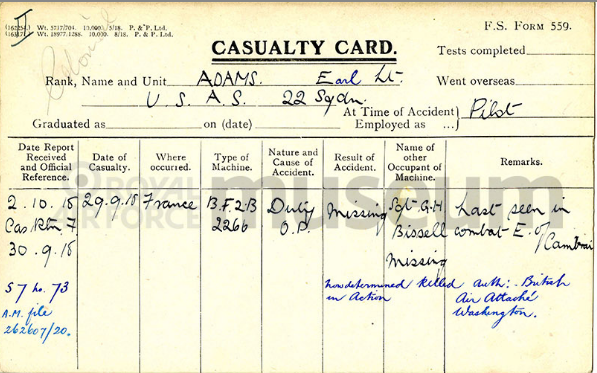
Afterwards
Adams was initially, in November 1918, reported as a prisoner of war and then, six months later, as missing in action.27 In early June 1919 Frederick William Zinn, tasked with locating the graves of missing U.S. airmen, responded to an inquiry from Professor Lord at O.S.U. about Adams. Zinn’s researches indicated that Adams “was never a prisoner in German hands,” but that
The German confirmation records for the date Lieut. Adams was reported missing show two Bristol fighters brought down by them in the area of the 17th German Army, one at Cagnoles [sic; sc. Cagnoncles], six km. East of Cambrai; the other at Iwuy, eight km. N.E. of Cambrai. Another record shows that the occupants of both these machines were killed. From all the information available it seems that Lieut. Adams was the occupant of one of these machines, probably the one that fell at Iwuy, but was buried by the Germans, possibly without a record ever having been made by them.28
Later secondary sources—Henshaw’s The Sky Their Battlefield II and The Jasta War Chronology by Franks et al.— document two Bristol F.2B’s brought down in the 17th German Army area: E2266 flown by Adams (who, along with Bissell, was killed) and E2517 flown by Thompson (who, along with his observer, was taken prisoner and survived). However, there are three German claims for Bristol Fighters brought down: Karl Fervers claimed a Bristol F.2B near Cagnoncles; Paul Keusen one near Iwuy; Paul Bäumer claimed one near Marcoing. Henshaw suggests that Bäumer’s claim was for Thompson’s E2517, and this would accord with Thompson’s recollection of having come down close to the lines where Germans were retreating (Marcoing had just been captured by the Allies).29 It seems possible that the claims of Keusen and Fervers were for one and the same plane, that of Adams; Cagnoncles is less than three miles from Iwuy, thus presumably both within a reasonable margin of error for describing the location of a crash site.
Zinn’s memo to Lord is dated June 3, 1919; on June 21, 1919, a body identified as that of Adams was disinterred from an “Isolated grave 100 meters NW of Rieux” (about 2 miles southeast of Cagnoncles, and about the same distance northeast of Iwuy). The original grave had been marked “with a cross as unknown British airman”; there was no identification on the body, which was “wrapped in overcoat badly decomposed.”30
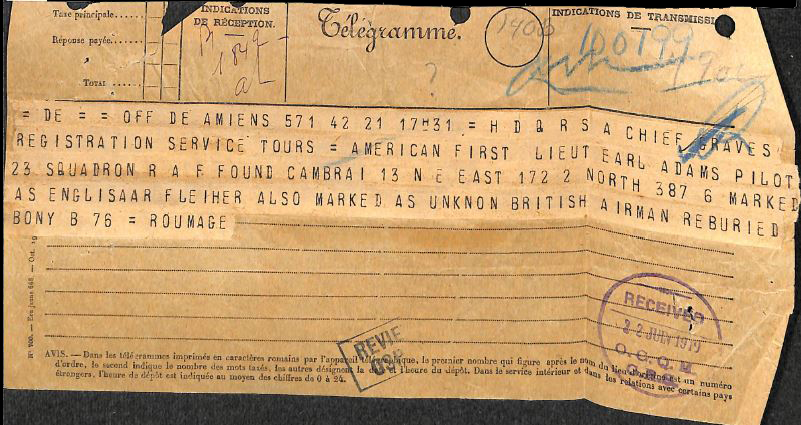
It is not apparent how the body was identified as Adams; the location may have provided the key; it is also likely that the recovery of Bissell’s body played a role. Unfortunately the relevant document related to Bissell (who was reburied in St. Aubert British Cemetery) appears not to be extant.31 Adams’s body was exhumed and reburied the day it was found, June 21, 1919, in American Military Cemetery # 636 at Bony in grave 99, row 4, plot D.32 Apparently independently, on that same day, Adams, because of the lapse of time, was officially moved to the killed in action list and appears as such in the casualty list released July 2, 1919.33
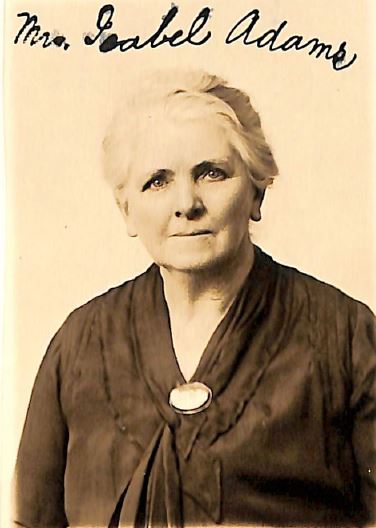
American next of kin of those killed in France in World War I were allowed to choose whether a body should remain in France or be returned to the U.S.; Adams’s mother chose in September 1920 that her son should remain in France.34 Over the course of the 1920s arrangements were made for permanent cemeteries and memorials for the American dead in France; there was reorganization and consolidation.35 Cemetery # 636 where Adams was buried became the Somme American Cemetery; and his final resting place became grave no. 2, block A, row 29.36 The cross marking his grave mistakenly indicates he was with the [U.S.] 22nd Aero Squadron.37
Besides his mother, Isabel, Adams left two sisters, Isabel and Margaret; neither had children, so there is no obvious repository for his effects.38 Isabel Adams was able to visit her son’s grave in 1930 as part of the Gold Star Mother Pilgrimage program.39
Nineteen year old Bissell, Adams’s gunner/observer, was the only child of Herbert Simeon and Florence Ada (née Horton) Bissell. Before he joined up he worked as a mechanic at a steel works near his home at Brierley Hill, Staffordshire. He served initially in Motor Transport, then in the Rifle Brigade. He transferred to the R.F.C. in about March of 1918 and trained at Reading and at Eastchurch. Qualified as a night-bombing observer, he went to France around September 8, 1918.40 He was initially reported as missing on September 29, 1918. An initial typed document recording his burial in the St. Aubert British Cemetery shows his last name corrected by hand to read “Bissell,” but in the permanent record he is “G. H. Bissel.”41
mrsmcq April 15, 2017; updated August 20, 2020, to reflect Milnor diary; revised September 2023 to provide information on family and to reflect burial file.
Notes
(For complete bibliographic entries, please consult the list of works and web pages cited.)
1 For Adams’s place and date of birth, see Ancestry.com, U.S., World War I Draft Registration Cards, 1917-1918, record for Earl Adams. The photo is a detail from a group photoof Squadron 8 taken by Frank Hager Haskett at Ohio State University on August 13, 1917.
2 On Adams’s descent and family, see records available at Ancestry.com. The documentation is sparse and sometimes contradictory; the 1900 census, for example, indicates that Isabel Brown Adams had born three children, all living; the 1910 census notes six born and four living.
3 Ancestry.com, 1910 United States Federal Census, record for Earl Adams.
4 “Ground School Graduations [for September 1, 1917].”
5 See Lord’s letter of March 5, 1919, included as p. 54 in Adams’s World War I Burial File.
6 Spalding, Rise to Follow, p. 221.
7 Murton Campbell, diary entry for September 22, 1917.
8 See, for example, the explanations supplied by Hamilton Hadley on p. 4 (286) of “Foreign Aviation Detachments,” by Geoffrey Dwyer on p. 2 of “Report on Air Service Flying Training Department in England,” and by Claude E. Duncan as recorded in Sloan and Hocutt, “The Real Italian Detachment,” p. 44.
9 Hooper, Somewhere in France, letter of November 14, 1917.
10 See The National Archives (United Kingdom), Royal Air Force officers’ service records 1918-1919, record for Earl Adams. On the other men posted to Wyton, see Foss, diary entry for November 15, 1917.
11 See Adams’s R.A.F. service record, cited above. On the location of No. 65 T.S. see Dolphin’s contribution to “W. J Salmons MM RAF 23/4/1918.” On the training planes used at 65, see A History of the American Air Service in Great Britain, p. 125, which is part of a list of stations where American pilots attached to the R.A.F. trained, along with names of planes used at each station. The list is incomplete, but presumably accurate as far as it goes. See also Sturtivant, Hamlin, and Halley, Royal Air Force Flying Training and Support Units, p. 302.
12 See cablegrams 612-S and 852-R.
13 Biddle, “Special Orders No. 35.”
14 See History of London Branch of the Supply Section and of Liquidation Section, charts 3 and 4; and the “War Service Record” completed by Isabel Adams in 1919 at Ancestry.com, Pennsylvania, WWI Veterans Service and Compensation Files, 1917-1919, 1934-1948, record for Earl Adams.
15 On the location of 1 A.S.D. see mickdavis’s contribution to “Marquise Aerodrome.”
16 Philpott, The Birth of the Royal Air Force, p. 394, lists 22’s locations and planes flown.
17 Otis Harold Williamson, according to the Maryland War Records Commission, Maryland in the World War, 1917-1919, was with the R.A.F. from July 8, 1918, until after the armistice, but that work provides no details of his R.A.F. service. The casualty form, “Lieut. Oteo [sic] Harold Williamson USAS,” shows Williamson posted to No. 22 Squadron on September 29, 1918. I find no R.A.F. service record for him. Harvey, “Pi” in the Sky, p. 36, refers to “O. W. Williamson.”
18 Harvey, “Pi” in the Sky, p. 36. On air involvement in the assault on the Hindenburg line, see Jones, The War in the Air, pp. 510 ff.
19 Harvey, “Pi” in the Sky, p. 36. And see Jones, The War in the Air, vol. 6, p. 505, regarding the raid on Emerchicout on September 17, 1918.
20 The letter is quoted and summarized in a newspaper article included in Adams’s file in the Pennsylvania, WWI Veterans Service and Compensation Files, 1917–1919, 1934–1948 (digitized at Ancestry.com). The name of the newspaper is not provided; the date was presumably November 23, 1918.
21 Harvey, “Pi” in the Sky, p. 36.
22 Jones, War in the Air, p. 517. Jones indicates that the times for the patrols were specified as 6 a.m., 11:30 a.m., and 5 p.m. It is evident from entries related to 22 Squadron for that day in Henshaw’s The Sky Their Battlefield II that these were not strictly adhered to, and Thompson’s letter, cited below, suggests that neither were the altitudes.
23 Lord’s letter of March 5, 1919, included as p. 54 in Adams’s World War I Burial File.
24 Quoted on pp. 78–79 of Harvey, “Pi” in the Sky; Harvey gives the last name as “Thomson.” The first ellipsis is in the text presented by Harvey; the other two are mine.
25 This is from the newspaper article of (probably) November 23, 1918 mentioned in an earlier note as included in Adams’s file in the Pennsylvania, WWI Veterans Service and Compensation Files, 1917–1919, 1934–1948 (digitized at Ancestry.com). There the letter is described as being from “Major J. Amphri, in charge of the lieutenant’s squadron”; I assume “Amphri” is a best guess at a scribbled signature.
26 “Adams, E. (Earl).”
27 “American Casualties,” col. 5, and “Today’s Casualty List.”
28 Zinn’s memo is included as p. 61 of Adams’s World War I burial file, q.v. Distressingly, Zinn, on May 10, 1919, had forwarded this information to the mother of Sgt. Earl Adams of Shelley, Idaho; fortunately this Adams had already returned home alive and well in April 1919.
29 “Capture of Marcoing.”
30 This is the information from the Graves Registration Service’s Form No. 16 (report of disinterment and reburial) that is included as p. 73 of Adams’s World War I Burial File.
31 War graves researcher Luc Degrande reviewed Commonwealth War Graves Commission digitial records but was unable to find a “Concentration of Graves (Exhumation and Reburials) Burial Return” form associated with Bissell’s reburial at St. Aubert—which would have indicated where the body was originally found. My correspondence with C.W.G.C. confirms that the form is not extant. I should note that Degrande brought to my attention the C.W.G.C. web site description of the St. Aubert British Cemetery, which refers to the reburial there of “two airmen from the United Kingdom, who fell in September 1918” and who had initially been buried “by the enemy” in the “Rieux-en-Cambrésis communal cemetery German extension.” This description would seem to match Adams and Bissell, and there appear to be no other likely candidates. However, the description is at odds with the statement that Adams’s body was found in an “isolated grave” and the fact that only Bissell was reburied at St. Aubert. In response to an inquiry by Degrande regarding the two British airmen buried at Rieux-en-Cambrésis cemetery, the Volksbund deutsche Kriegsgräberfürsorge indicated that they have no relevant documentation.
32 See G.R.S. form No. 16, p. 73 of Adams’s World War I Burial File.
33 See correspondence on p. 53 of Adams’s World War One Burial File; “Phila Lieutenant Killed.”
34 See pp. 38–43 of Adams’s World War One Burial File.
35 See Hatzinger, “Democracy of Death,” Chapter 3, passim.
36 There must be or must have been paperwork recording the change from grave 99, row 4, plot D to grave no. 2, block A, row 29, but it is not in Adams’s World War One Burial File. The document pp. 30–31 of the file records only a disinterment from grave 6 and reburial in grave 2 within block A, row 29, on March 29, 1928.
37 See CWGC/ABMC [pseud.], “1LT Earl Adams.” It is evident from documents in Adams’s World War One Burial File that his attachment to the R.A.F. was poorly understood.
38 See Ancestry.com, 1930 United States Federal Census, record for Isabelle [sic] Adams.
39 See Ancestry.com, New York, Passenger Lists, 1820-1957, record for Isabel Adams, as well as Sewell and Palin, eds., U.S. World War I Mothers’ Pilgrimage, 1929, record for Mrs. Isabel Adams. Many of the documents in Adams’s World War One Burial File relate to arrangements for the pilgrimage.
40 “Round Oak Observer Missing.” Bissell’s parents’ names are taken from birth and marriage documents available at Ancestry.com. Other information is taken from The National Archives (United Kingdom), Royal Air Force officers’ service records 1918-1919, record for George Herbert Bissell, which indicates he went to “B.E.F.” September 8, 1918; there is no specific mention of No. 22 Squadron.
41 “Bissel [sic], G. H.”

